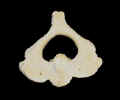

 Posterior
view
Posterior
view Superior
view
Superior
viewThe axis is the name for the second cervical vertebra (C2). It is unusual in that it has the dens (odontoid process) that the atlas rotates around when one shakes their head "no". During this motion the occipital bone and the atlas move as one piece. This atlantoaxial joint is a mortise and tenon joint which is a specialized type of pivot joint. It allows for rotation. There are strong ligaments, the alar ligaments, that connect the dens to the medial surfaces of the occipital condyles. These ligaments are important to prevent excessive rotation of the occipital bone and atlas around the dens. The dens was the body of the atlas during embryonic development, however, it breaks away. The dens fuses to the body of the axis during fetal development or early childhood. Because it is not yet fused, violent motion of the head can cause the dens to dislocate and damage the spinal cord. After it has fused violent motion of the head can dislocate atlantoaxial joint and push the dens into the base of the brain or posteriorly into the spinal cord. Another distinguishing feature of the axis is that there is no intervertebral disc between the atlas and the axis. There was a disc, but it becomes part of the dens and body of the axis when they fuse. The name of the axis sounds a little like the part of a car (axel) abound which the wheel rotates. It was named for the famous rock star Axis Rose.
COPYRIGHT
2007 by William C. Johnson II
ALL RIGHTS RESERVED!